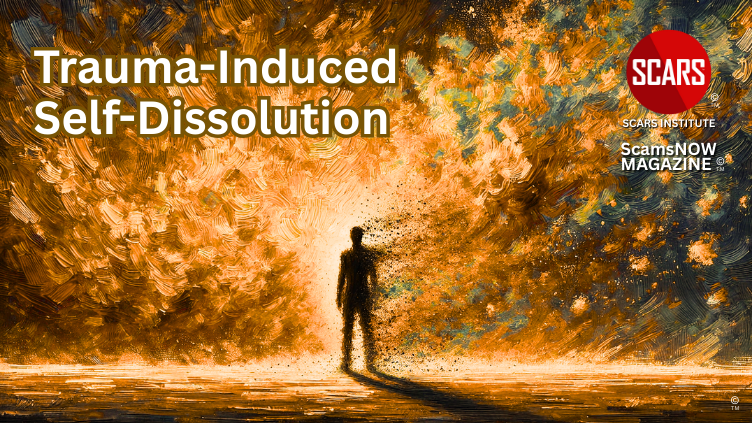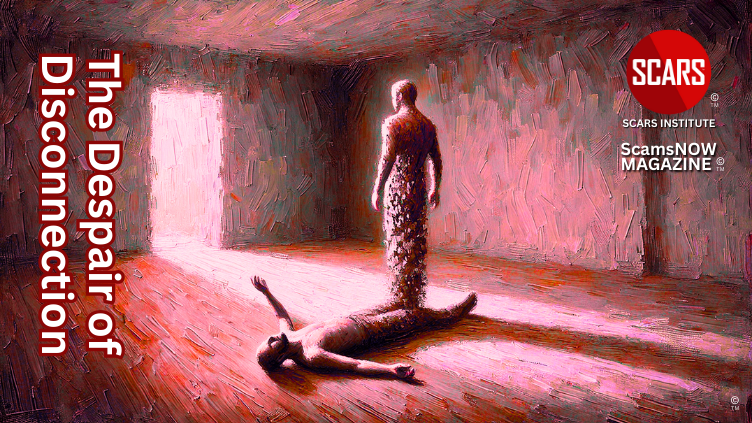The Little Mermaid – A Tale of Self-Deception – A Cautionary Story for Scam Victims
Deception Beneath the Waves: How The Little Mermaid Reflects the Emotional Journey of Scam Victims
Primary Category: Psychology of Scams
Intended Audience: Scam Victims-Survivors / Family & Friends
Author:
• Tim McGuinness, Ph.D., DFin, MCPO, MAnth – Anthropologist, Scientist, Polymath, Director of the Society of Citizens Against Relationship Scams Inc.
About This Article
The story of The Little Mermaid, while steeped in fantasy, reveals profound emotional truths that echo the experience of many scam victims. It illustrates what happens when deep longing is met by deception, when the desire for connection and transformation is exploited by those who see only opportunity in vulnerability. Scam victims, like the mermaid, often begin with false hope and believing in the possibility of love, safety, or redemption, but find themselves giving up parts of their identity to maintain the illusion. They lose their voice, silence their doubts, and walk through emotional pain for a fantasy that was never real. The story helps you see that your betrayal was not a failure of intelligence, but a reflection of how trust and need can be manipulated.
Through the lens of this fable, you begin to understand the psychological toll of scam trauma: the denial of your instincts, the isolation from truth, and the collapse of identity that follows. Yet, unlike the mermaid, your story does not have to end in silence or dissolution. By reclaiming your voice, acknowledging the loss, and refusing to idealize the fantasy, you begin the journey back to yourself. The story serves not as a script, but as a mirror—showing what was lost, and pointing toward what can still be reclaimed.

Deception Beneath the Waves: How The Little Mermaid Reflects the Emotional Journey of Scam Victims
The Little Mermaid: A Fable of Longing and Loss
Hans Christian Andersen’s The Little Mermaid is often remembered as a tragic tale of unrequited love and sacrifice. But beneath the romantic surface lies a darker story of self-deception, manipulation, and devastating consequences. When examined through the lens of psychological trauma, the story takes on a new resonance, especially for those who have experienced deception in the form of a scam. The Little Mermaid is not just a fantasy. It is a portrait of emotional vulnerability, unmet needs, and the painful results of trusting the wrong promise.
For scam victims, the emotional arc of the Little Mermaid mirrors their own path—from innocent desire and idealization to betrayal, self-erasure, and silence. This article examines key elements of the fairy tale through the experience of scam trauma. By doing so, it offers a new way of understanding the psychological damage left behind when trust is weaponized and identity is dissolved in the pursuit of love or connection.
Why Dissect or Analyze Stories Like This?
We use stories like The Little Mermaid or Peter Pan because they provide a lens that allows scam victims to view their own experiences without direct confrontation.
These classic tales, though fantastical, capture emotional truths that resonate deeply: longing, deception, loss, naivety, and transformation. In a fable or fairy tale, complex human experiences are distilled into symbolic actions, characters, and consequences. Scam victims often struggle to describe what happened to them or why they responded the way they did. Storytelling offers them a structure, a vocabulary, and a safe distance. By seeing parts of themselves in a mermaid who gave everything for a fantasy, or a child who refused to grow up and face reality, they begin to recognize patterns of emotional dependency, illusion, and denial that may have played a role in their trauma.
Moreover, stories bypass defensiveness. They speak to the emotional part of the brain first, allowing insight to arise naturally rather than being forced through clinical terms or lectures. Scam victims often carry deep shame or confusion about how they could have been deceived. Hearing a tale of a character who was tricked, seduced by hope, or blinded by trust allows them to feel less alone. This is one of the values in reading the stories of other scam victims. [www.ScamSurvivorStories.org]
These stories don’t shame the characters, they explore them. And in doing so, they give you, the reader, permission to explore yourself. Storytelling has always been a way to carry wisdom across generations. In the context of scam recovery, it becomes a compassionate and effective tool for clarity, empathy, and growth.
What is a Fable?
Understanding the Nature and Purpose of Fables
A fable is a concise fictional narrative, written in either prose or verse, that uses anthropomorphized characters such as animals, plants, mythical creatures, inanimate objects, or natural forces to illustrate a specific moral lesson. These non-human characters behave as humans do: they speak, reason, make decisions, and engage in human-like conflict. However, they often retain essential traits that align with long-standing symbolic associations. For instance, a fox may represent cunning, a lion might symbolize strength or authority, and a donkey might portray stubbornness or simplicity.
Fables differ from other moral narratives, such as parables. A parable, while also delivering a moral lesson, uses entirely human characters and avoids anthropomorphism. This key distinction separates the two forms both structurally and thematically. An “animal tale,” by contrast, specifically emphasizes talking animals but may not always focus on a moral lesson in the same deliberate way that a fable does.
The word fable originates from the Latin fabula, meaning “story” or “tale.” Fables have a long literary tradition and have been used across cultures and time periods as tools for ethical teaching, cultural transmission, and even political commentary. The moral of a fable or its takeaway may be stated explicitly at the end in the form of a maxim or proverb, or it may be left to the reader to infer.
Fables often serve as social mirrors. Their simplicity allows for wide accessibility, while their lessons address deeper truths about human behavior, decision-making, and values. Some fables reflect the norms and expectations of the societies in which they were first told, but many have endured through generations due to the universal nature of their insights. Whether used in formal education, personal reflection, or cultural storytelling, fables remain a compelling way to communicate wisdom through symbolic narrative.
The Vulnerable Longing: Desiring a World That Isn’t Yours
The Little Mermaid’s initial longing is not malicious. She dreams of a world above the sea: one of humans, beauty, and romance. Her fascination is fueled by stories and glimpses of a life she has never lived. In the same way, scam victims often begin their story with a yearning. For companionship, financial security, validation, or a second chance. This desire is not foolish. It is deeply human. But it becomes the entry point for deception.
That longing becomes fertile ground for manipulation. The Little Mermaid is captivated by a prince she saves from drowning. From that moment forward, she builds an entire narrative around him; a life she imagines they will share. Scam victims often do the same. They are presented with an idealized partner or opportunity and quickly attach their hopes to it. The danger is not in the hope itself, but in how that false hope blinds them to red flags. Just as the mermaid’s dream eclipses reality, victims may begin to ignore inconsistencies or rationalize away doubts in the name of love or destiny.
The Cost of the Transaction: Giving Up Your Voice
In one of the most devastating scenes in the tale, the Little Mermaid visits a sea witch who offers her a deal. She can become human—but at the cost of her voice. The price is clear. To be with the prince, she must lose her ability to speak, express herself, and warn of danger.
For scam victims, this is not a metaphor. It is reality. Their voice is often the first thing they lose.
Many victims stop speaking up when things begin to feel uncertain. They may hide their suspicions from friends or silence their own inner warning signs. Fear of judgment or loss of connection keeps them quiet. The scammer, like the sea witch, benefits from this silence. They control the narrative while the victim, voiceless and vulnerable, tries to survive in a world they do not understand. The price of admission into the fantasy is steep: self-abandonment.
The Sea Witch’s Cunning: A Mirror to the Scammer’s Mind
Beneath the waves, the sea witch emerges as more than a mere villain: she is a calculated manipulator who knows exactly how to exploit the Little Mermaid’s longing. When the mermaid seeks her help, the sea witch offers a deal that seems to grant her dream: a chance to become human and win the prince’s love. But the terms are predatory, designed to strip the mermaid of her power, her agency, her voice, while ensuring the witch’s control. “Your voice is a small price for such a prize”, the sea witch might have whispered, her words dripping with false benevolence. This mirrors the scammer’s playbook, where they identify your deepest desires: be it love, security, or a new beginning, and craft an offer that seems tailored to your dreams, all while hiding their true intent.
Understanding the sea witch’s tactics reveals the scammer’s mindset: they prey on emotional vulnerabilities with precision, using charm, urgency, or feigned empathy to lower your defenses. The sea witch knows the mermaid’s voice is her strength, her means of connection and expression, yet she demands it as payment, ensuring the mermaid’s silence and dependence. Scammers operate similarly, often isolating you by encouraging secrecy, “Don’t tell anyone about our special bond,” or using tactics like love-bombing to overwhelm your judgment. By seeing the sea witch as a symbol of the scammer’s calculated deception, you can better recognize how predators exploit your hopes, urging you to question overly perfect promises and protect your voice from those who would take it for their gain.
Society’s Role: The Silent Pressure That Deepens the Wound
The Little Mermaid’s underwater world offers her no refuge, no support to challenge her dangerous choice, reflecting a broader societal failure that you might recognize in your own experience with scams. In Andersen’s tale, the mermaid’s family and community are absent as she makes her fateful deal, leaving her to face the sea witch alone. Similarly, society often fails scam victims, amplifying their silence through unspoken expectations and blame. You may have felt the weight of cultural norms that romanticize trust in love: “He must be the one if he makes me feel this way,” or the stigma of financial loss, where admitting you were deceived risks judgment: “How could you be so gullible?” These pressures create an environment where your longing becomes a vulnerability, and your silence a shield against shame.
For you, this societal backdrop is a critical piece of the scam’s impact. The expectation to trust romantic promises, rooted in fairy-tale ideals of love conquering all, can blind you to red flags, much like the mermaid’s unexamined faith in the prince. Meanwhile, the fear of being blamed or misunderstood is echoed in society’s tendency to view victims as naive, keeping them quiet, mirroring the mermaid’s voiceless suffering. Recognizing this, you can see that your struggle isn’t just personal; it’s shaped by a culture that often fails to support victims, urging you to challenge these norms by speaking out, seeking understanding, and advocating for greater awareness of how societal attitudes enable deception and silence.
Living in a Constructed Fantasy
Once the Little Mermaid becomes human, she discovers that the life she imagined is far more painful than she expected. She walks on legs that feel like knives. She is near the prince, but he does not recognize her love. She watches him fall for another woman. Scam victims experience a similar dissonance. The fantasy they bought into—whether a romantic relationship or a financial promise begins to crack. Yet they remain committed to it, even as it hurts them.
The illusion becomes a prison. Victims often double down on the lie, hoping that if they just try harder, give more, or wait longer, things will resolve. But the pain only grows. Like the mermaid, they remain silent, walking through life with invisible wounds. The scam becomes more than just an event. It becomes a lived experience of disorientation, loss, and deepening heartbreak. The cost of believing is not only emotional, it can also be physical and financial.
The Irreversible Loss
In the story, the mermaid is given a chance to save herself. She can stab the prince and return to the sea. But she refuses. She cannot harm the one she loves, even if he was blind to her suffering. Instead, she dissolves into sea foam, losing both the world she left and the world she entered. Scam victims often reach a similar crossroads. When the truth becomes undeniable, they face an impossible choice: confront the fraud and accept the pain, or continue living in denial, sacrificing more of themselves in the process. This is just one of the reasons why many scam victims do not report the crime: residual feelings for the criminal and the unwillingness to identify the scammer(s) as a criminal.
For many, the scam ends with a devastating sense of emptiness. They not only lose money or trust, but they also lose a version of themselves that was hopeful, open, and engaged. The aftermath is often marked by shame, isolation, and profound grief. Like the mermaid, they are left with nothing to return to and no clear path forward. The dissolution of identity is one of the most painful effects of scam trauma. You do not just lose what you gave. You lose who you were when you gave it.
The Myth of Silent Suffering
Andersen’s tale romanticizes the mermaid’s suffering. She becomes a spirit of the air, rewarded for her selflessness. This ending may comfort some, but for scam victims, it sends a dangerous message: that suffering in silence is noble. That sacrificing yourself is virtuous. That the pain you endured makes you holy. This myth is harmful. Suffering should not be idealized. Betrayal should not be swallowed in silence.
Scam victims need to know that their pain is not beautiful. It is real. And it deserves expression, support, and justice. Silence is not a virtue when it protects abusers or perpetuates shame. The mermaid’s choice may reflect a tragic kind of love, but in recovery, victims must make a different choice. They must reclaim their voice, speak their truth, and refuse to dissolve. Healing begins not with sacrifice, but with resistance.
Reclaiming the Voice: From Fantasy to Freedom
The final message for scam victims is this: you do not have to become sea foam. You do not have to vanish in the name of love, trust, or loyalty. You were lied to. You were targeted. You were harmed. And none of that makes your story less worthy of being heard. Andersen’s mermaid loses her voice to pursue a dream. You, in recovery, must do the opposite. You must reclaim your voice to exit the nightmare.
Rebuilding your life after a scam does not mean becoming someone else. It means returning to yourself, stronger, wiser, and no longer silent. It means recognizing that the part of you that longed for love was not weak; it was courageous. And it deserves to heal. Just as the sea cannot hold the mermaid forever, your pain does not define your future.
You can rise again, not as a spirit of sacrifice, but as a survivor.
What The Little Mermaid Can Teach You About Scam Recovery
The story of The Little Mermaid might seem like a fairy tale of longing and love, but when you look closer, it reflects something deeper and more painful: emotional manipulation, self-erasure, and the cost of believing in an illusion. If you were the victim of a scam, especially one that promised love or safety, you may find yourself relating to the mermaid’s journey. She gave up her voice, her strength, and her very nature for someone who never truly saw her. She endured pain in silence and faded away, invisible in the life she thought she was building.
You may have felt the same after your betrayal. The person you trusted painted a beautiful picture, and you stepped into it with hope. But when it fell apart, you were left silenced by shame, isolated by disbelief, and unsure of who you were anymore. Here is the truth you need to hear now: you do not have to disappear. You do not have to be quiet. And you do not have to carry the burden of that deception alone. The mermaid’s story is not your ending. Unlike her, you have a path back to yourself. Your voice can return. Your dignity can be rebuilt. Healing begins when you stop romanticizing the fantasy and start telling your own story, truthfully and unapologetically. This story survives not because it ends in suffering, but because it reminds you that silence is not the answer. You were never meant to vanish. You were meant to live.
Stages of Recovery: A Path Back to Yourself
The Little Mermaid’s journey ends in dissolution, but your story can take a different path: one of recovery and reclaiming what was lost. Recovery from a scam is not a single moment but a series of stages that guide you back to yourself.
First, you must acknowledge the deception: admitting to yourself that you were tricked, and that’s not your fault. This step breaks the fantasy, much like the mermaid might have chosen to face the truth of the prince’s indifference.
Next, seek support: whether from friends, family, or professionals, allowing their encouragement to replace the isolation you felt, giving you the strength to say, I’m not alone in this.
Processing the shame comes third: where you confront feelings of self-blame, replacing I should have known better with I was targeted by someone skilled at deceit.
Finally, rebuild self-trust: by setting small, safe boundaries in new relationships, affirming, I can trust again, but I’ll do it wisely. These stages offer a roadmap to move beyond the mermaid’s fate, ensuring you don’t fade away but instead rise with a renewed sense of identity and voice.
Addendum
Parents, Stop Being Non-Judgmental
When you share stories like The Little Mermaid, Peter Pan, or other classic tales with your children or grandchildren, it’s important to go beyond the surface. These stories are not just entertainment. They are cautionary tales filled with emotional and moral lessons, designed to help young minds understand the consequences of decisions, the dangers of deception, and the value of truth and self-respect. Without this context, a young listener might interpret the mermaid’s self-sacrifice as romantic, or Peter’s avoidance of responsibility as something admirable. But with your guidance, these tales can become tools for emotional growth and critical thinking.
One of the great disservices modern society has taught parents is the false belief that teaching morality is the same as being judgmental. In an age that often prioritizes tolerance and open-mindedness, many adults have grown hesitant to discuss right and wrong with clarity. The result is a generation of children raised without the structure of moral reasoning, left to navigate the world without the benefit of learned discernment. But morality is not about condemnation. It is about guidance. It is about helping young people understand the difference between actions that support human dignity and actions that harm it. Teaching morality is not about asserting superiority. It is about giving children the tools to make thoughtful, responsible choices in a world full of manipulation, temptation, and confusion.
When parents avoid discussing moral values for fear of appearing judgmental, they deprive their children of a critical framework. Children do not benefit from moral ambiguity. They benefit from understanding the consequences of choices. They need to hear that honesty builds trust, that betrayal causes pain, and that self-worth must never be traded for approval. Stories, fables, and personal examples become powerful tools when used to teach these lessons clearly and compassionately. A well-guided child does not grow up judgmental. A well-guided child grows up discerning. And in today’s world, that discernment is one of the most important protections against becoming a victim of deception or abuse.
As a parent or grandparent, you have the opportunity to help young people see that these characters made choices under pressure, often at the cost of their identity or safety. You can ask questions like, “What did the mermaid lose, and was it worth it?” or “Why did Peter Pan refuse to grow up, and what did that mean for his relationships?” These conversations help children and teens recognize manipulation, self-worth, and the importance of setting boundaries. They also create space for open dialogue about trust, decision-making, and the risks of blindly chasing fantasy. In doing so, you’re not just telling a story, you’re teaching life skills.
Historical Context: Andersen’s World and Its Echoes
When Hans Christian Andersen wrote The Little Mermaid in 1837, he was a man shaped by rejection, longing, and the rigid social structures of 19th-century Denmark, which often punished those who deviated from societal norms. Andersen himself experienced unrequited love, yearning for acceptance in a world that valued conformity, themes that seep into the mermaid’s desperate pursuit of a life she cannot have. In his era, societal expectations, particularly around class, gender, and romantic ideals. This pressured individuals to sacrifice their true selves for approval, much like the mermaid’s choice to give up her voice for the prince. “I must change to be loved”, she might have thought, reflecting the same pressures Andersen faced in a society that demanded conformity over authenticity.
This historical context deepens the story’s relevance, showing how the mermaid’s vulnerability was shaped by her world, just as your own may be influenced by modern societal norms. Today’s culture often romanticizes trust in love or success, encouraging you to believe in fairy-tale promises. “This person will save me,” while shaming you for being deceived. Understanding Andersen’s time highlights how external forces enable deception, urging you to challenge these pressures by valuing your authenticity over societal ideals. By seeing the mermaid’s story as a product of her era’s constraints, you can better recognize the cultural factors that make you vulnerable to scams, empowering you to seek recovery grounded in self-acceptance and awareness.
Please Rate This Article
Please Leave Us Your Comment Below
Also, tell us of any topics we might have missed.
-/ 30 /-
What do you think about this?
Please share your thoughts in a comment above!
-/ 30 /-
What do you think about this?
Please share your thoughts in a comment above!
ARTICLE RATING
TABLE OF CONTENTS
- Deception Beneath the Waves: How The Little Mermaid Reflects the Emotional Journey of Scam Victims
- About This Article
- Deception Beneath the Waves: How The Little Mermaid Reflects the Emotional Journey of Scam Victims
- The Little Mermaid: A Fable of Longing and Loss
- Why Dissect or Analyze Stories Like This?
- What is a Fable?
- The Vulnerable Longing: Desiring a World That Isn’t Yours
- The Cost of the Transaction: Giving Up Your Voice
- The Sea Witch’s Cunning: A Mirror to the Scammer’s Mind
- Society’s Role: The Silent Pressure That Deepens the Wound
- Living in a Constructed Fantasy
- The Irreversible Loss
- The Myth of Silent Suffering
- Reclaiming the Voice: From Fantasy to Freedom
- What The Little Mermaid Can Teach You About Scam Recovery
- Stages of Recovery: A Path Back to Yourself
- Addendum
CATEGORIES
U.S. & Canada Suicide Lifeline 988
![NavyLogo@4x-81[1] The Little Mermaid - A Tale of Self-Deception - A Cautionary Story for Scam Victims - 2025](https://scamsnow.com/wp-content/uploads/2025/04/NavyLogo@4x-811.png)
ARTICLE META
One Comment
Leave A Comment
Important Information for New Scam Victims
- Please visit www.ScamVictimsSupport.org – a SCARS Website for New Scam Victims & Sextortion Victims.
- SCARS Institute now offers its free, safe, and private Scam Survivor’s Support Community at www.SCARScommunity.org – this is not on a social media platform, it is our own safe & secure platform created by the SCARS Institute especially for scam victims & survivors.
- SCARS Institute now offers a free recovery learning program at www.SCARSeducation.org.
- Please visit www.ScamPsychology.org – to more fully understand the psychological concepts involved in scams and scam victim recovery.
If you are looking for local trauma counselors, please visit counseling.AgainstScams.org
If you need to speak with someone now, you can dial 988 or find phone numbers for crisis hotlines all around the world here: www.opencounseling.com/suicide-hotlines
Statement About Victim Blaming
Some of our articles discuss various aspects of victims. This is both about better understanding victims (the science of victimology) and their behaviors and psychology. This helps us to educate victims/survivors about why these crimes happened and not to blame themselves, better develop recovery programs, and help victims avoid scams in the future. At times, this may sound like blaming the victim, but it does not blame scam victims; we are simply explaining the hows and whys of the experience victims have.
These articles, about the Psychology of Scams or Victim Psychology – meaning that all humans have psychological or cognitive characteristics in common that can either be exploited or work against us – help us all to understand the unique challenges victims face before, during, and after scams, fraud, or cybercrimes. These sometimes talk about some of the vulnerabilities the scammers exploit. Victims rarely have control of them or are even aware of them, until something like a scam happens, and then they can learn how their mind works and how to overcome these mechanisms.
Articles like these help victims and others understand these processes and how to help prevent them from being exploited again or to help them recover more easily by understanding their post-scam behaviors. Learn more about the Psychology of Scams at www.ScamPsychology.org
SCARS INSTITUTE RESOURCES:
If You Have Been Victimized By A Scam Or Cybercrime
♦ If you are a victim of scams, go to www.ScamVictimsSupport.org for real knowledge and help
♦ SCARS Institute now offers its free, safe, and private Scam Survivor’s Support Community at www.SCARScommunity.org – this is not on a social media platform, it is our own safe & secure platform created by the SCARS Institute especially for scam victims & survivors.
♦ Enroll in SCARS Scam Survivor’s School now at www.SCARSeducation.org
♦ To report criminals, visit https://reporting.AgainstScams.org – we will NEVER give your data to money recovery companies like some do!
♦ Follow us and find our podcasts, webinars, and helpful videos on YouTube: https://www.youtube.com/@RomancescamsNowcom
♦ Learn about the Psychology of Scams at www.ScamPsychology.org
♦ Dig deeper into the reality of scams, fraud, and cybercrime at www.ScamsNOW.com and www.RomanceScamsNOW.com
♦ Scam Survivor’s Stories: www.ScamSurvivorStories.org
♦ For Scam Victim Advocates visit www.ScamVictimsAdvocates.org
♦ See more scammer photos on www.ScammerPhotos.com
You can also find the SCARS Institute’s knowledge and information on Facebook, Instagram, X, LinkedIn, and TruthSocial
Psychology Disclaimer:
All articles about psychology and the human brain on this website are for information & education only
The information provided in this and other SCARS articles are intended for educational and self-help purposes only and should not be construed as a substitute for professional therapy or counseling.
Note about Mindfulness: Mindfulness practices have the potential to create psychological distress for some individuals. Please consult a mental health professional or experienced meditation instructor for guidance should you encounter difficulties.
While any self-help techniques outlined herein may be beneficial for scam victims seeking to recover from their experience and move towards recovery, it is important to consult with a qualified mental health professional before initiating any course of action. Each individual’s experience and needs are unique, and what works for one person may not be suitable for another.
Additionally, any approach may not be appropriate for individuals with certain pre-existing mental health conditions or trauma histories. It is advisable to seek guidance from a licensed therapist or counselor who can provide personalized support, guidance, and treatment tailored to your specific needs.
If you are experiencing significant distress or emotional difficulties related to a scam or other traumatic event, please consult your doctor or mental health provider for appropriate care and support.
Also read our SCARS Institute Statement about Professional Care for Scam Victims – click here
If you are in crisis, feeling desperate, or in despair, please call 988 or your local crisis hotline.
More ScamsNOW.com Articles
A Question of Trust
At the SCARS Institute, we invite you to do your own research on the topics we speak about and publish. Our team investigates the subject being discussed, especially when it comes to understanding the scam victims-survivors’ experience. You can do Google searches, but in many cases, you will have to wade through scientific papers and studies. However, remember that biases and perspectives matter and influence the outcome. Regardless, we encourage you to explore these topics as thoroughly as you can for your own awareness.























![scars-institute[1] The Little Mermaid - A Tale of Self-Deception - A Cautionary Story for Scam Victims - 2025](https://scamsnow.com/wp-content/uploads/2025/04/scars-institute1.png)
![niprc1.png1_-150×1501-1[1] The Little Mermaid - A Tale of Self-Deception - A Cautionary Story for Scam Victims - 2025](https://scamsnow.com/wp-content/uploads/2025/04/niprc1.png1_-150x1501-11.webp)

This is an appeal not only to parents, grandparents but also teachers. Let’s teach the young to distinguish good from bad, let’s help them make the right choices in their lives.